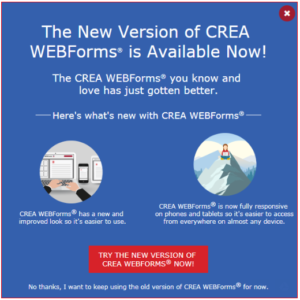Jul 10, 2018 | CREA/OREA/RECO News, MLS®, Stats & Technology |
CREA will be discontinuing their WEBForms® Classic version as of Wednesday, August 8, 2018.
To prepare for the change to the new version of WEBForms®, why not begin using it now? It’s easy to find the new site: when you go to WEBForms® Classic, you will see the notice shown below – just click on the red button that says Try the new version of CREA WEBFORMS® now! and you will be redirected to the site.

Note: This article was updated on July 18 to reflect the new date of August 8 for the discontinuation of WEBForms® “Classic”.
Jun 19, 2018 | CREA/OREA/RECO News |
We have received the following information from the Canadian Real Estate Association (CREA):
The Canadian Radio-television and Telecommunications Commission (CRTC) continues to enforce compliance with the Unsolicited Telecommunications Rules or the National Do Not Call List (DNCL). The DNCL includes consumer telephone numbers who have chosen to no longer receive marketing calls.
The DNCL was established in September 2008 and CREA has communicated requirements to its members on numerous occasions. There have been several messages to Boards and Associations, News2Me articles, multiple blog posts and a full compliance guide is available on REALTOR Link® to help members understand their obligations.
It is important for brokerages to understand their responsibilities and ensure full compliance. Failure to do so may result in significant financial penalties administered by the CRTC. We encourage you to review the steps below and update your internal policies accordingly.
- If a brokerage makes calls or sends faxes to consumers for the purpose of solicitation, the brokerage must register at http://go.pardot.com/e/94862/ind-insorg-regorg-eng/2x3rk6/201912085.
- If a brokerage signs a contract with a telemarketing service provider to do telemarketing on their behalf, the brokerage must still register at http://go.pardot.com/e/94862/ind-insorg-regorg-eng/2x3rk6/201912085.
- If a brokerage or their service provider conducts telemarketing, the brokerage must purchase a subscription for the area codes that will be called.
- It is the responsibility of the brokerage to ensure its office has access to the most up-to-date version of the National DNCL and that those numbers are removed from the calling list.
The DNCL applies to brokerages as well as service providers. We urge brokerages to exercise caution when hiring a third party service provider to assist in managing their telemarketing operations. Hiring a third party to manage a brokerage’s telemarketing operations does not absolve the brokerage of its DNCL responsibilities. Each brokerage is responsible for calls made on their behalf, therefore, if the service provider does not abide by the law, the brokerage may be at risk, particularly if the CRTC launches an investigation.
For more information about the DNCL and members’ obligations, please consult CREA’s FAQs or contact us at info@crea.ca.

Apr 3, 2018 | CREA/OREA/RECO News, DS |
CREA recently released its 2017 REALTOR.ca Insights Report, which provides valuable market trends, consumer statistics, and information you can share with your clients about the value of using a REALTOR® and REALTOR.ca.
Here are some highlights from the report about Canada’s Number One real estate website!
- 6 million leads were sent to REALTORS® (through Email REALTOR®, Email Office and Phone a REALTOR® buttons)
- There was an average of 300,000 listings on REALTOR.ca at any given time
- There were 264 million visits to REALTOR.ca – 15 per cent more visits than last year!
- REALTOR® profiles were viewed over 6.1 million times
- There were 965 million views of property listings – up 64 per cent from last year!
Read the entire 2017 REALTOR.ca Insights Report here! (Note: This information was sent to all members in the March issue of CREA’s NEWS2Me newsletter.)

Mar 6, 2018 | CREA/OREA/RECO News, DS |

Did you know that you can save commonly used clauses in CREA WEBForms® so you can access them quickly?
Creating, accessing and viewing clauses in CREA WEBForms® is easy:
- Login to CREA WEBForms® on your mobile device at WEBForms.ca.
- Click on Clauses in the main navigation.
- Create, edit or view any clauses.
You can also create a master kit of commonly used forms and clauses.
You can then use these master kits to create transaction kits, build custom clauses or edit existing ones to tailor real estate forms to fit your needs.
Feb 13, 2018 | CREA/OREA/RECO News, DS |
 Have you seen the new CREA WEBForms®? WEBForms® has a new and improved look and is available everywhere on almost any device.
Have you seen the new CREA WEBForms®? WEBForms® has a new and improved look and is available everywhere on almost any device.
Check it out here: https://webforms.realtorlink.ca/webforms5/kits/
Nov 28, 2017 | CREA/OREA/RECO News |
The federal government released Canada’s first ever National Housing Strategy (NHS). The strategy is a 10-year, $40-billion plan focused on giving more Canadians a place to call home.
The Canadian Real Estate Association (CREA) was pleased to participate in the consultations and provided input through a submission in 2016. The submission emphasized the importance of maintaining a complete view of the housing spectrum, which includes keeping homeownership as an affordable and accessible housing option for all Canadians.
The goal of the NHS is to ensure Canadians have access to housing that meets their needs and is affordable.
Over the next 10 years, the government will focus on the following aspects:
Housing Rights Are Human Rights—The federal government intends to take steps to ensure the right of every Canadian to access adequate housing through the creation of new programs, such as the Federal Housing Advocate and a National Housing Counsel.
National Housing Co-Investment Fund—$15.9 billion commitment to create 60,000 new units of housing and repair up to 240,000 existing social housing units.
Canada Community Housing Initiative—$4.3 billion to support provinces and territories to protect and build a sustainable community-based housing sector.
National Housing Benefit—$4 billion to support struggling and low-income households who can’t make ends meet, in both social and private market housing.
Federal-Provincial/Territorial Housing Partnership—An additional $16.1 billion in federal investment to provincial and territorial housing programs (cost-matching programs).
Improving Homeownership Options for Canadians—Through government-backed mortgage loan insurance and better detection and prevention of mortgage fraud.
Evidence-Based Housing: Research, Data and Modelling—$241 million for housing research and data, to ensure better housing information is available to all levels of governments to make educated, research-evidence based data-driven housing policy decisions.
CREA applauds the government for recognizing that there are housing challenges and needs across the entire housing spectrum. However, CREA is disappointed that housing affordability for all Canadians was not adequately addressed and will continue to push the government to recognize that affordability challenges exist for more than just lower income Canadians.
May 15, 2017 | CREA/OREA/RECO News |
According to statistics released by The Canadian Real Estate Association (CREA), national home sales declined in April 2017.
Highlights:
- National home sales fell 1.7% from March to April.
- Actual (not seasonally adjusted) activity in April was down 7.5% from a year earlier.
- The number of newly listed homes jumped 10% from March to April.
- The MLS® Home Price Index (HPI) was up 19.8% year-over-year (y-o-y) in April 2017.
- The national average sale price rose 10.4% y-o-y in April.
Home sales over Canadian MLS® Systems fell by 1.7% in April 2017 from the all-time record set in March.
May 5, 2017 | CREA/OREA/RECO News |
New FINTRAC requirements that were announced in 2016 are just now coming into effect for REALTORS® on various dates starting June 17, 2017.
These changes will affect you in four ways:
1.The way you identify individuals has been improved to add more flexibility.
There are three methods for identification:
- Using a single piece of government-issued photo identification
- Verifying that the client’s name, date of birth and address match information obtained from a Canadian credit bureau that has been in existence for at least three year
- Using two original, valid and current documents or information from independent and reliable sources, such as utility bills or bank statements
2. Whenever your brokerage uses a mandatary to identify a client on your behalf, you will now have to keep more detailed records of when you received identification information from the mandatary. You will also need to review the information to make sure nothing is missing.
3. The regulations expand on existing obligations to keep a record when you use reasonable measures to satisfy certain obligations under the law. The reasonable measure record obligations are reflected in:
- New sections A.4 and B.1 in the Individual Identification Information Record
- New sections A.3 and B.1 in the Corporation/Entity Identification Information Record
- New section E of the Receipt of Funds Record (which has also been reorganized to reflect additional FINTRAC guidance)
- New records related to large cash transactions and suspicious transactions
4. Clients who have been identified by your brokerage in the past do not need to be identified again if you or your Broker of Record/Manager have no doubts about the information you obtained previously.
This is only a very brief summary of the changes taking effect in June, 2017. To read the details and get the information you need about changes to forms and what it all means for you, go to the CREA site on REALTOR Link® and check out the new information in the Compliance Centre. [REALTOR Link > CREA > Resources and Compliance > Compliance Resources > Money Laundering (FINTRAC)].
Once you are on the FINTRAC page, be sure you check out the links to helpful documents near the bottom of the page – all the material has been updated. The FAQ document may be particularly helpful.
____________________________________________________________________________________
All CREA forms have been updated to reflect your new obligations under FINTRAC. Revised forms are now available on WEBForms®. (Note: you may use your old forms until June 17, 2017. After that time, only the revised forms will satisfy your obligations.)
Mar 24, 2017 | CREA/OREA/RECO News |

2016 was a busy year for REALTOR.ca with over 240 million visitor sessions and over 300,000 REALTOR.ca accounts created. This means REALTORS® were sent over 1.9 million email leads throughout the year.
Since February, of this year, REALTOR.ca has been making sure you get the most out of your leads with the launch of smart leads. These emails, which are generated when a visitor to your REALTOR.ca listings or profile sends you a lead, will provide you with more information than ever before.
REALTOR.ca smart leads give you more insight into your leads with the addition of the following information:
- Real estate persona: Are they a first time buyer, residential investor, repeat buyer?
- Where they are from: Is your lead local, from out of town or even international?
- Do they have representation: Want to know if they are already working with a REALTOR®? Find out before you even talk to them.
REALTOR.ca smart leads provide additional information to help you build stronger, smarter connections with potential clients.
If you have any questions please contact CREA Member Support.
Note: Users have the option to choose to not share certain types of information when sending an email to a REALTOR®.
Feb 3, 2017 | CREA/OREA/RECO News |
CREA has prepared a brochure outlining ManuLife Group Insurance benefits for which you may be eligible, and the brochure will be coming to your office in February! Watch for your copy and see what benefits are available to you! Don’t want to wait til then? You can also visit Manulife for more information.
Feb 3, 2017 | RAHB News |
RAHB will soon be participating in CREA’s MLS® Home Price Index!
What’s the MLS® Home Price Index?
The MLS® Home Price Index, or HPI, is a tool for gaining a better understanding of the market trends in the residential market in our area, and how those trends compare to the rest of the country.
When we talk about housing prices, we usually refer to trends in average and median sale prices. These measures are readily available and easily understood. However, averages and medians do not always accurately determine trends because:
- data can be skewed by outliers
- all homes are treated as equal
- home “composition” is not taken into consideration
The MLS® HPI provides a better measurement of price and price trends for residential properties. It is based on real MLS® listing content from RAHB – that is, the attributes of the listed properties: number of bedrooms, number of baths, number of storeys, etc. The HPI uses that information to calculate what is the average home in an area, and then it can track how that average home price changes over time.
How does it work?
The HPI uses a base – or benchmark – year as a starting point for price comparison. The index base is always 100.
In RAHB’s case, the benchmark year is 2005, so the HPI value for, say, January 2005 is 100. If the HPI value for a single-family home in January of 2011 is 167.1, you know that the value of a typical single-family home is up 67.1 per cent compared to 2005.
What’s in it for you?
The real value of the HPI comes with the depth of information available to members. The HPI drills down into areas as well as types of properties – single family, townhouse and apartment. For each area, the HPI defines what the “average” house, townhouse and apartment is. In one area the average single family home might be a 3-bedroom, 2-bath, double garage home, while in another area it is a 2-bedroom, 1-bath home with no garage. Likewise for the townhouse and apartment categories – the HPI definition is determined by the mix of properties and their features in that area. This allows you to see trends that average or median sale prices just can’t provide.
RAHB will be publishing general information about the HPI, the same way it publishes general statistics, so the public will see what the general trend is. However, RAHB members will have access to much more detailed information, so you will be able to:
- help your clients understand home price trends for specific kinds of properties in a given neighbourhood
- position yourself as a credible, reliable source of insight into the real estate market
- broaden your knowledge of municipal, regional and national real estate markets, and compare trends in those markets
What the MLS® HPI doesn’t do
The HPI will not predict future price trends. It can only be used to track what the trend has been and what it is at the present time.
What’s the next step?
Once RAHB starts reporting the MLS® HPI trends for our area, you will have access to an HPI dashboard via REALTOR Link®. That’s where you will find the more detailed information the public doesn’t see. You will find information about housing trends in our area, as well as trends in other cities where HPI is reported.
How did the MLS® HPI come about?
It was pioneered by six founding partners: the real estate boards of Calgary, Fraser Valley, Greater Montreal, Greater Vancouver, and Greater Toronto and the Canadian Real Estate Association. In 2009, the partners contracted with Altus Group to develop the MLS® HPI, which subsequently launched in February 2012.
Since its founding, CREA’s Home Price Index has grown to include data from Regina, Saskatoon, Ottawa, Vancouver Island, Victoria and Greater Moncton, and will soon include some regional MLS® boards and associations, as well as RAHB.
Want more information?
Gregory Klump, CREA’s Chief Economist, will be presenting two knowledge pods on the HPI at REALTOR® CONNECTIONS AGM, Conference and Trade Show on March 9, and will return to RAHB after we launch the HPI to do more information sessions. Watch for more info about the date, time and location of the presentations.
You can also find more information about the MLS® Home Price Index.
Jan 11, 2017 | CREA/OREA/RECO News |
CREA is looking for candidates for the 2017-2018 Board of Directors. There are four Director-at-Large positions available (three for a two-year term and one for a one-year term) and four Regional Director positions available (for British Columbia/Yukon, Manitoba, Quebec and the Atlantic Region).
Qualifications for Directors:
1. Be a REALTOR® member
2. Have been a REALTOR® member for at least five years
3. Have a minimum of three years’ experience within the last 10 years as a director of a Canadian not-for-profit corporation or a public body
4. Otherwise not be disqualified by the Canada Not-for-Profit legislation
5. In the case of a Regional Director, be licensed in that region
6. If elected, must have completed leadership courses set out in CREA policy within one year of being elected.
The deadline for submissions is January 26, 2017. The election for Directors-at-Large will take place at CREA’s Annual General Meeting in Ottawa on Monday, March 27, 2017. Regional Director elections will take place prior to the CREA AGM.
Want more information?
Check out the video at:
http://www.realtorlink.ca/content/realtorlink/crea/en_CA/about/governance/elections.html
More information about CREA and CREA Directors:
http://rahb.ca/CREA/2017/CREARecruitmentLetter2017.pdf
Apply to be part of the future of real estate in Canada!:
http://fluidsurveys.com/surveys/crea-communications/crea-director-elections-2017/?l=en





 Have you seen the new CREA WEBForms®? WEBForms® has a new and improved look and is available everywhere on almost any device.
Have you seen the new CREA WEBForms®? WEBForms® has a new and improved look and is available everywhere on almost any device.